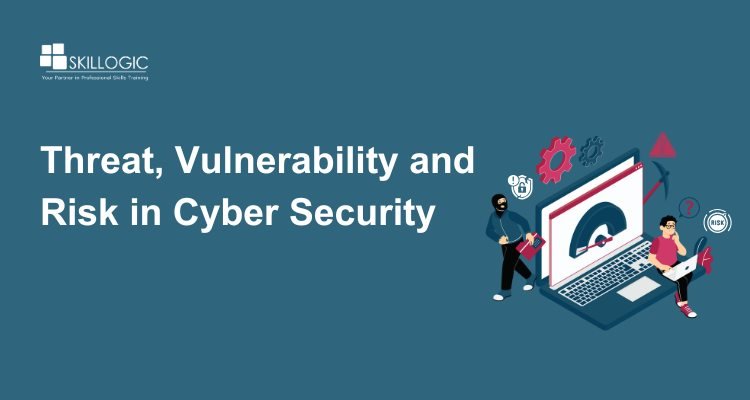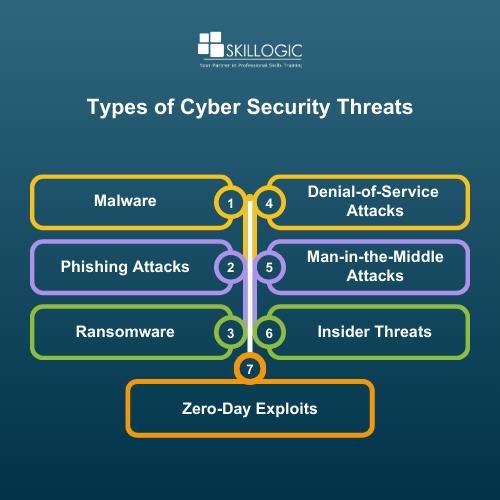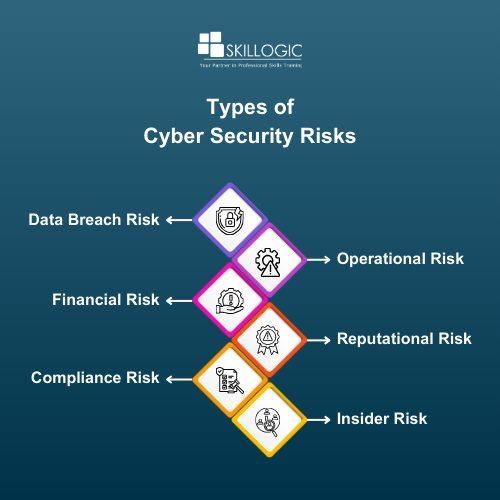Threat, Vulnerability and Risk in Cyber Security
Gain a clear understanding of Threat, Vulnerability and Risk in Cyber Security, three foundational elements that shape any effective security strategy. Explore how these factors interconnect, how to identify them, and what steps to take for reducing cyber threats and protecting critical data.

Cyber security is about keeping your devices, networks, and information safe from hackers and other online threats. But to stay truly safe, you need to understand three key terms: threats, vulnerabilities, and risks. Though they’re often used together, each one means something different. Knowing the threat, vulnerability and risk in cyber security is the first step to building strong digital defenses.
As cyber attacks become more frequent and advanced, the demand for protection is rising fast. According to Grand View Research, the global cyber security market was valued at USD 245.62 billion in 2024 and is expected to grow at 12.9% CAGR from 2025 to 2030. In this article, we’ll break down these terms in simple words and explain how they’re all connected.
What is a Cyber Security Threat?
A cyber security threat is anything that can cause harm to your data, devices, or systems. It could be a hacker, malware, phishing email, or even a natural disaster that affects your data center. Think of it as a potential danger. It hasn't happened yet, but it could. These information security threats can come from outside or even from within your organization.
Examples of cyber security threats:
- A hacker trying to steal your passwordsa
- A virus that deletes files
- Ransomware locking your system for money
These cyber security threats and vulnerabilities are always evolving, so staying updated is important. Regular monitoring and timely action can prevent small issues from turning into major cyber security risks.
Types of Cyber Security Threats:
To better protect your systems, it's essential to know the different types of threats out there. Some of the most common include:
- Malware: Malicious software like worms, viruses, trojans, and spyware designed to damage or steal data.
- Phishing Attacks: Fake emails or messages that trick users into revealing sensitive information like login credentials or credit card numbers.
- Ransomware: A type of malware that locks your files or systems until a ransom is paid.
- Denial-of-Service (DoS) Attacks: These overwhelm a system or network, causing it to become inaccessible to users.
- Man-in-the-Middle (MitM) Attacks: Hackers intercept communications between two parties to steal or alter data.
- Insider Threats: Employees or partners misusing access to cause harm, either intentionally or by accident.
- Zero-Day Exploits: Cyberattacks that take advantage of software flaws that are unknown to the vendor or haven't been fixed yet.

By understanding these information security threats and how they relate to your system's weaknesses, you can better manage and reduce your overall cyber security risks. With the global cyber security market projected to surge from $172.24 billion in 2023 to $562.72 billion by 2032 as reported by Fortune Business Insights, it's clear that organizations worldwide are prioritizing stronger defenses and smarter risk management strategies.
Refer these articles:
- Offensive vs Defensive Cyber Security: What Should You Learn
- Does Cyber Security Require Coding
- Remote Cyber Security Jobs: Is It the Future
What is a Vulnerability in Cyber Security?
A vulnerability is a flaw or weakness in your system that a threat can take advantage of. This could be outdated software, weak passwords, or an open port in your network. If a cyber security threat takes advantage of a weakness in your system, it can lead to serious damage like stolen data or system failure. That’s why it’s important to keep your software updated and use strong security settings to close those gaps before attackers find them.
Examples of vulnerabilities:
- Unpatched operating systems
- Using "123456" as a password
- Employees clicking on suspicious links
In short, a vulnerability is like an open door, and the threat is whatever tries to walk through it. Understanding threats and vulnerabilities in cyber security helps organizations fix weak spots before something bad happens.
Types of Cyber Security Vulnerabilities:
Here are some common types of vulnerabilities that can compromise system security:
- Software Vulnerabilities: Bugs, flaws, or outdated software that attackers can exploit.
- Network Vulnerabilities: Open ports, insecure Wi-Fi, or weak firewall rules.
- Human Vulnerabilities: Employees falling for phishing emails or using poor password practices.
- Configuration Vulnerabilities: Incorrectly set up systems, apps, or cloud services.
- Physical Vulnerabilities: Unprotected hardware, stolen devices, or unauthorized access to servers.
These cyber security threats and vulnerabilities often work together. Fixing one without addressing the other leaves your system exposed. That’s why understanding both is key to preventing cyber security risks.
Refer these articles:
- Cyber Security Scope in India
- How to Become a Cyber Security Expert in India
- How much is the Cyber Security Course Fee in India
What is Risk in Cyber Security?
Now that you know about threats and vulnerabilities, let’s talk about cyber security risk. A cyber security risk is the chance that a threat will successfully exploit a vulnerability and cause harm. It's all about how likely an attack is and how much damage it could cause.
Cyber security risks vary depending on:
- How valuable your data is,
- How exposed your systems are,
- How strong your defenses are,
For example, if you store customer data on an outdated system without regular updates, and hackers are actively exploiting such weaknesses, your cyber security risk becomes significantly high. In fact, Cybersecurity Ventures estimates that global cybercrime damages will soar to $10.5 trillion per year by 2025, up significantly from $3 trillion in 2015.
Meanwhile, a single data breach costs businesses an average of $3.86 million, according to IBM’s 2020 report, impacting not just finances but also legal standing and brand reputation. That’s why understanding the risks, threats and vulnerabilities in cyber security helps organizations prioritize key actions and make smarter investments in protection.
Types of Cyber Security Risks:
There are several types of cyber security risks that businesses and individuals should be aware of:
- Data Breach Risk: When sensitive data (like customer info or financial records) is exposed or stolen.
- Operational Risk: When an attack disrupts business operations, such as shutting down systems or halting services.
- Financial Risk: Losses due to fraud, ransom payments, or penalties from non-compliance.
- Reputational Risk: Damage to your brand image or customer trust after a cyber incident.
- Compliance Risk: Failing to meet industry standards or legal regulations related to data protection.
- Insider Risk: Risks coming from within the organization, like employee misuse or accidental data leaks.

In cyber security, the terms threat, vulnerability, and risk are closely linked, but each plays a unique role. Recognizing how they connect gives you a better view of where you’re most at risk and how to build a stronger defense against cyber security threats and vulnerabilities.
Threat vs Vulnerability vs Risk: Key Differences
A cyber security threat is anything that has the potential to cause harm, like a hacker trying to access sensitive information, malware attempting to infect your system, or even an employee accidentally leaking data. These threats are constantly evolving, making it critical to stay alert.
Now, a vulnerability is a weakness that gives these threats an entry point. It could be outdated software, a misconfigured server, weak passwords, or even untrained staff. These cyber security threats and vulnerabilities work hand in hand without a vulnerability, the threat has no way in.
This leads us to risk, which is the possibility that a threat will successfully exploit a vulnerability and cause damage, such as stealing data, shutting down services, or draining financial resources. In other words, risk is the outcome that can occur when threats and vulnerabilities meet.
For example, if a company hasn’t updated its firewall in months, and a hacker targets that gap, the chance of a data breach becomes a real cyber security risk. And that risk isn’t just technical, it can result in legal issues, loss of customer trust, and heavy financial penalties.
That’s why knowing how threats and vulnerabilities in cyber security lead to cyber security risks is so important. It allows organizations to prioritize what to fix first and where to focus their time, tools, and budget. Simply put, the better you understand the connection between risks, threats and vulnerabilities in cyber security, the better you can protect your digital world.
Refer these articles:
- How much is the Cyber Security Course Fees in Bangalore
- How to Choose the Best Institute for Cyber Security in Bangalore
- How to Choose Best Institute for Cyber Security in Hyderabad
How to Prevent These Cyber Security Threat, Vulnerability, and Risk
Preventing cyber security threats and vulnerabilities requires a proactive approach. The goal is to stay one step ahead of attackers by reducing weaknesses and minimizing the chances of damage. By identifying the threats and vulnerabilities in cyber security early, you can significantly lower your overall cyber security risks.
Here are some effective ways to protect your systems and data:
1. Update Software Regularly
Always install the latest security patches and updates. Many cyber security threats exploit known vulnerabilities in outdated software. Regular updates help close those gaps and reduce your exposure to information security threats.
2. Use Strong Passwords & Multi-Factor Authentication (MFA)
Simple or reused passwords are an open door to attackers. Encourage the use of strong, unique passwords and enable MFA wherever possible. This adds an extra layer of protection against cyber security threats and vulnerabilities.
3. Train Employees
A large number of cyber security risks stem from human error. Regular training helps employees recognize phishing emails, suspicious links, and other information security threats. Cyber awareness is a key defense tool.
4. Install Firewalls & Antivirus Software
Good security tools are your first line of defense. Firewalls help keep intruders out, and antivirus programs find and get rid of harmful software. These tools are essential for minimizing threats and vulnerabilities in cyber security.
5. Monitor & Test Your Systems
Regular vulnerability assessments and penetration testing can uncover hidden weaknesses. Monitoring tools alert you to unusual activity, helping you catch cyber security threats before they escalate.
6. Backup Data
Ransomware is one of the fast-growing information security threats. Regular data backups ensure you don’t lose everything if a breach occurs. Store backups securely and test them often.
7. Limit User Access & Permissions
Allow staff to use just the systems and information they need to perform their duties. This limits the potential damage from internal cyber security threats and vulnerabilities, whether intentional or accidental.
In short, in cyber security, knowing what you're up against makes all the difference. Threats, vulnerabilities, and risks in cyber security may sound similar, but each plays a unique role in shaping your defense strategy. When you understand how they connect, you can spot weaknesses faster and respond smarter.
Instead of reacting to attacks after they happen, focus on prevention, keep systems updated, train your team, and monitor regularly. Cyber attacks may be inevitable, but with the right knowledge and action, major damage doesn’t have to be.
If you're exploring cyber security institutes in Bangalore, it's worth checking out top training hubs in cities like Chennai, Ahmedabad, Coimbatore, Hyderabad, Pune, and Mumbai. These cities host well-established institutes offering both offline and classroom-based programs to help you build a strong foundation in cyber security.
SKILLOGIC stands out as a leading cyber security training provider in India, known for delivering high-quality education tailored to current industry demands. With over a decade of experience and more than 100,000 professionals trained worldwide, SKILLOGIC offers both online and offline learning options to suit your style.
Learners at SKILLOGIC Institute gain practical experience, guidance from industry experts, and earn globally recognized certifications from NASSCOM FutureSkills and IIFIS. You'll also get 24/7 access to cloud-based labs, internship opportunities, and full placement support to launch or grow your career.
The Cyber Security Professional Plus course blends real-world simulations with expert instruction, ensuring you're job-ready. The cyber security course is available at SKILLOGIC’s offline cyber security institutes in Hyderabad, Bangalore, Pune, Chennai, Coimbatore, Ahmedabad, and Mumbai, as well as online and helping you stay ahead in a fast-changing digital landscape.

0
225